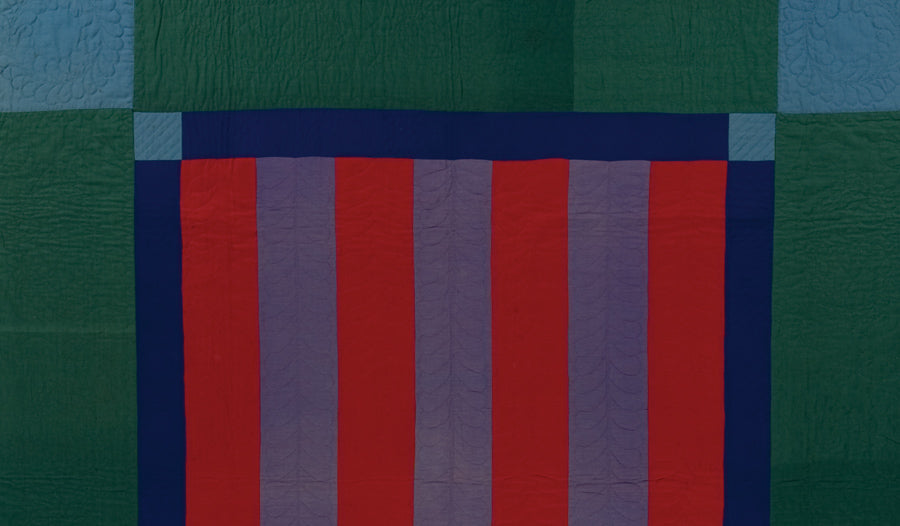
PLAIN & SIMPLE
 Image: Bars, maker unknown, Pennsylvania, c1920. Photograph © The International Quilt Museum, University of Nebraska-Lincoln.
Image: Bars, maker unknown, Pennsylvania, c1920. Photograph © The International Quilt Museum, University of Nebraska-Lincoln.
Next to the traditional American block-style quilts, the quilts of the Amish people of North America are probably the most highly acclaimed. Indeed, they were described by the late Australian art critic Robert Hughes as being ‘aesthetically radiant objects.’ They are simple designs, executed in a limited palette of rich colours that positively glow. The exquisite stitching make the quilts of the Amish women stand out.
Sixteen such quilts–ten from Pennsylvania and six from the Midwest–from part of the the collection of the International Quilt Museum in Nebraska. They showcased the height of Amish quiltmaking– typically thought to be from the late 1800s to 1950–highlighted the iconic designs and illustrated the subtle differences found therein.
To fully appreciate the aesthetics of these quilts, it helps to understand them in context. The Amish are an austere, religious people, the direct descendants of the Swiss Alps Anabaptists who arrived in the United States in the early 1700s. By the end of the twentieth century, they were living in twenty-two American states and one Canadian province.
 Image: Floating Bars quilt, maker unknown, Lancaster Country, Pennsylvania, c 1940. Photograph © Museum of Fine Arts, Boston
Image: Floating Bars quilt, maker unknown, Lancaster Country, Pennsylvania, c 1940. Photograph © Museum of Fine Arts, Boston
The Amish live an essentially rural, separate existence from mainstream American life. They keep to their ‘old’ ways, rejecting American culture and the common dream of corporate success. Referring to non-Amish people as ‘English’, their religion and sense of community are an inherent part of their lives. The home is the focal point for the family and extended families stay close together, often on the same farm. Summed up by the German word ‘gelassenheit’, conformity to family and church are of the utmost importance for this community.
The lives of the Amish are ruled by the ‘Ordnung’, the rules that are set down by the elders in each community, varying amongst the settlements. Pennsylvanian Amish communities tend to be stricter than their Indiana and Ohio neighbours. Some communities integrate with outsiders more than others–for example driving cars for essential tasks–whilst other communities will only use horses and buggies. The essence of their lives is simplicity and self-denial, and these beliefs are expressed in every aspect of their lives. Ornamentation and unnecessary embellishment are not a part of their homes or clothing, for example. Their clothing separates the Amish from the non Amish, reinforcing this sense of community. The outer-clothes are usually sombre, though underneath there is a greater variety of solid colours than might be at first supposed. bright red is used rarely and it is unusual to see true yellow, white or orange. Patterned fabric is totally rejected, as it is considered too decorative and fussy for Amish clothing.

Image: Center Diamond, maker unknown, Pennsylvania, c1910. Photograph © The International Quilt Museum, University of Nebraska-Lincoln.
Therefore, this same colour palette is used in the quilts, as they utilise many of the remaining scraps from the same fabrics that make up their clothing. It is rare for an Amish woman to use light colours as a dominant feature, and black is used by Lancaster County Amish only as an accent colour. It is the startling combinations of deep colours that make the quilts so memorable: deep reds and blues, purples, greens and turquoise. The juxtaposition of the brilliant colours resonate with the eye. Nowadays, quiltmaking is an important source of income and Amish women have incorporated patterned and pastel fabrics. They likewise select newer quilt designs to appeal to the tastes of potential customers...
Extract from the article, Plain & Simple: Quilts from the Amish Community, written by Dr Sue Marks in the current issue of Selvedge, Issue 105 Checks & Stripes. Find out how to read the full article here:

